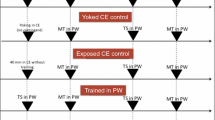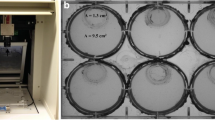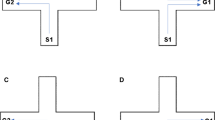Abstract
Frequently studies of learning and memory measure a single focal behaviour; however it is likely that any learning paradigm will alter multiple behavioural traits in the same animal. We used video footage of the great pond snail (Lymnaea stagnalis), collected immediately prior to both training and testing for memory in response to operant conditioning to reduce aerial respiration, to measure two additional alternate behavioural traits: reducing the size of the pneumostome (breathing orifice) opening and shell tilt to cover the pneumostome. Typically, the training regime used here results in memory to reduce the number of breathing attempts lasting 24 h but not 72 h. However, memory duration when measured using the two additional behavioural traits differed significantly; shell tilt was short-lived lasting less than 1 h following training, whereas the reduction in pneumostome size was still apparent 72 h following training. Therefore, conclusions about the ability of L. stagnalis to retain memory in response to a single type of training regime will differ significantly depending on the focal behavioural trait measured. A significant correlation between the reduction in opening attempts and visible pneumostome area indicated that these behavioural traits are co-specialised, whereas pneumostome opening and shell tilt behaviour varied independently.






Similar content being viewed by others
References
Auld JR, Agrawal AA, Relyea RA (2010) Re-evaluating the costs and limits of adaptive phenotypic plasticity. Proc R Soc B-Biol Sci 277(1681):503–511. doi:10.1098/rspb.2009.1355
Benjamin PR, Kemenes G (2008) Behavioral and circuit analysis of learning and memory in mollusks. In: Byrne JH (ed) Learning and memory: a comprehensive reference. Academic Press, Oxford, pp 587–604
Braun MH, Lukowiak K (2011) Intermediate and long-term memory are different at the neuronal level in Lymnaea stagnalis (L.). Neurobiol Learn Mem 96(2):403–416
Briffa M, Rundle SD, Fryer A (2008) Comparing the strength of behavioural plasticity and consistency across situations: animal personalities in the hermit crab Pagurus bernhardus. Proc R Soc B-Biol Sci 275(1640):1305–1311. doi:10.1098/rspb.2008.0025
Covich AP (2010) Winning the biodiversity arms race among freshwater gastropods: competition and coexistence through shell variability and predator avoidance. Hydrobiologia 653(1):191–215. doi:10.1007/s10750-010-0354-0
Dalesman S, Lukowiak K (2010) Effect of acute exposure to low environmental calcium alters respiration and locomotion of Lymnaea stagnalis (L.). J Exp Biol 213:1471–1476. doi:10.1242/jeb.040493
Dalesman S, Braun MH, Lukowiak K (2011a) Low environmental calcium blocks long term memory formation in a pulmonate snail. Neurobiol Learn Mem 95:393–403. doi:10.1016/j.nlm.2010.11.017
Dalesman S, Rundle SD, Lukowiak K (2011b) Microgeographic variability in long-term memory formation in the pond snail, Lymnaea stagnalis. Anim Behav 82:311–319. doi:10.1016/j.anbehav.2011.05.005
Dingemanse NJ, Kazem AJN, Reale D, Wright J (2010) Behavioural reaction norms: animal personality meets individual plasticity. Trends Ecol Evol 25(2):81–89. doi:10.1016/j.tree.2009.07.013
Inoue T, Takasaki M, Lukowiak K, Syed NI (1996) Inhibition of the respiratory pattern-generating neurons by an identified whole-body withdrawal interneuron of Lymnaea stagnalis. J Exp Biol 199(9):1887–1898
Jenkins J, Dallenbach K (1924) Obliviscence during sleep and waking. Am J Psychol 35:605–612
Kita S, Hashiba R, Ueki S, Kimoto Y, Abe Y, Gotoda Y, Suzuki R, Uraki E, Nara N, Kanazawa A, Hatakeyama D, Kawai R, Fujito Y, Lukowiak K, Ito E (2011) Does conditioned taste aversion learning in the pond snail Lymnaea stagnalis produce conditioned fear? Biol Bull 220(1):71–81
Kraemer PJ, Golding JM (1997) Adaptive forgetting in animals. Psych Bull Rev 4:480–491. doi:10.3758/BF03214337
Lukowiak K, Ringseis E, Spencer G, Wildering W, Syed N (1996) Operant conditioning of aerial respiratory behaviour in Lymnaea stagnalis. J Exp Biol 199(3):683–691
Lukowiak K, Cotter R, Westly J, Ringseis E, Spencer G, Syed N (1998) Long-term memory of an operantly conditioned respiratory behaviour pattern in Lymnaea stagnalis. J Exp Biol 201(6):877–882
Lukowiak K, Adatia N, Krygier D, Syed N (2000) Operant conditioning in Lymnaea: evidence for intermediate- and long-term memory. Learn Mem 7(3):140–150. doi:10.1101/lm.7.3.140
Lukowiak K, Sangha S, Scheibenstock A, Parvez K, McComb C, Rosenegger D, Varshney N, Sadamoto H (2003) A molluscan model system in the search for the engram. J Physiol Paris 97:69–76. doi:10.1016/j.jphysparis.2003.10.008
McComb C, Sangha S, Qadry S, Yue J, Scheibenstock A, Lukowiak K (2002) Context extinction and associative learning in Lymnaea. Neurobiol Learn Mem 78(1):23–34. doi:10.1006/nlme.2001.4041
Mery F, Burns JG (2010) Behavioural plasticity: an interaction between evolution and experience. Evol Ecol 24:571–583. doi:10.1007/s10682-009-9336-y
Orr M, Hittel K, Lukowiak K (2009a) Different strokes for different folks: geographically isolated strains of Lymnaea stagnalis only respond to sympatric predators and have different memory forming capabilities. J Exp Biol 212:2237–2247. doi:10.1242/jeb.031575
Orr M, Hittel K, Lukowiak KS, Han J, Lukowiak K (2009b) Differences in LTM-forming capability between geographically different strains of Alberta Lymnaea stagnalis are maintained whether they are trained in the lab or in the wild. J Exp Biol 212(23):3911–3918. doi:10.1242/jeb.024281
Parvez K, Stewart O, Sangha S, Lukowiak K (2005) Boosting intermediate-term into long-term memory. J Exp Biol 208(8):1525–1536. doi:10.1242/jeb.01545
Parvez K, Rosenegger D, Orr M, Martens K, Lukowiak K (2006) Canadian association of neurosciences review: learning at a snail’s pace. Can J Neurol Sci 33(4):347–356
Relyea RA (2002) Costs of phenotypic plasticity. Am Nat 159(3):272–282. doi:10.1086/338540
Rescorla RA, Holland PC (1982) Behavioural-studies of associative learning and animals. Annu Rev Psychol 33:265–308. doi:10.1146/annurev.ps.33.020182.001405
Rundle SD, Brönmark C (2001) Inter- and intraspecific trait compensation of defence mechanisms in freshwater snails. Proc R Soc B-Biol Sci 268(1475):1463–1468
Sangha S, McComb C, Scheibenstock A, Johannes C, Lukowiak K (2002) The effects of continuous versus partial reinforcement schedules on associative learning, memory and extinction in Lymnaea stagnalis. J Exp Biol 205(8):1171–1178
Sangha S, McComb C, Lukowiak K (2003) Forgetting and the extension of memory in Lymnaea. J Exp Biol 206(1):71–77. doi:10.1242/jeb.00061
Sangha S, Scheibenstock A, Martens K, Varshney N, Cooke R, Lukowiak K (2005) Impairing forgetting by preventing new learning and memory. Behav Neurosci 119(3):787–796. doi:10.1037/0735-7044.119.3.787
Spear NE, Miller JS, Jagielo JA (1990) Animal memory and learning. Annu Rev Psychol 41:169–211
Syed NI, Winlow W (1991) Coordination of locomotor and cardiorespiratory networks of Lymnaea stagnalis by a pair of identified interneurons. J Exp Biol 158:37–62
Wasserman EA (1981) Response evocation in autoshaping: contributions of cognitive and comparative-evolutionary analyses to an understanding of directed action. In: Locurto CM, Terrace HS, Gibbon J (eds) Autoshaping and conditioning theory. Academic Press, New York
Wixted JT (2004) The psychology and neuroscience of forgetting. Annu Rev Psychol 55:235–269
Acknowledgments
We would like to thank 3 anonymous reviewers for their comments that helped improve this manuscript. S.D. is supported by an Alberta Heritage Foundation for Medical Research postdoctoral fellowship from Alberta Innovates—Health Solutions, Canadian Institutes for Health Research support K.L. and the laboratory.
Ethical standard
The experiments presented here comply with the law of the country in which they were performed.
Author information
Authors and Affiliations
Corresponding author
Rights and permissions
About this article
Cite this article
Dalesman, S., Lukowiak, K. Alternate behavioural measurements following a single operant training regime demonstrate differences in memory retention. Anim Cogn 15, 483–494 (2012). https://doi.org/10.1007/s10071-012-0472-3
Received:
Revised:
Accepted:
Published:
Issue Date:
DOI: https://doi.org/10.1007/s10071-012-0472-3




